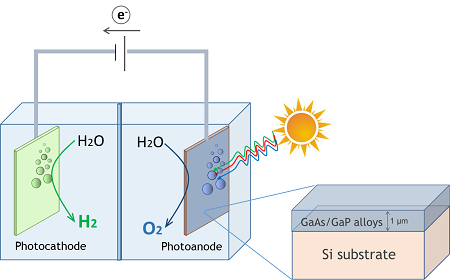Thanks to a high energy density and carbon-free advantage, hydrogen (H2) holds great promises to reduce global energy dependence on fossil fuels. Therefore, the conversion of solar energy into chemical energy in the form of H2 via water splitting is of great interest. In this context, the development of high-efficiency semiconductor photoelectrodes at low manufacturing cost remains still challenging despite the numerous recent researches in the field.
The direct bandgap III–V semiconductors have emerged as promising candidates, as they provide a large photon-to-electron conversion rate, much higher than those of metal oxide semiconductors and traditional silicon. Especially, the use of III-V alloys allows to benefit from bandgap engineering to achieve desired photoelectrodes requirements.
In this thesis, I explore the development of these photoelectrodes on a low-cost Si substrate, while many research studies proposed the use of high-cost commercial III-V wafers. In this work, we show that 1-µm thick epitaxial III-V films grown on a low-cost Si substrate can produce a competitive photocurrent to those measured for expensive III-V commercial wafers. Especially, we demonstrated that the optical and Photo-Electro-Chemical performances of GaAsP/Si photoelectrodes are deeply impacted by the variations of the bandgap and band-lineups. Attempts to protect the photoelectrodes against corrosion are also presented.

| Yamina ANDRE | Associate Professor, Institut Pascal, UCA | Examinator |
| José PENUELAS | Associate Professor, INL, ECL | Examinator |
| Murielle CHAVAROT-KERLIDOU | Director of research, LCBM, CNRS | Member |
| Bruno FABRE | Director of research, ISCR, CNRS | Member |
| Nicolas BERTRU | Professor, Institut Foton, INSA Rennes | PhD Supervisor |
| Charles CORNET | Professor, Institut Foton, INSA Rennes | PhD Supervisor |

































